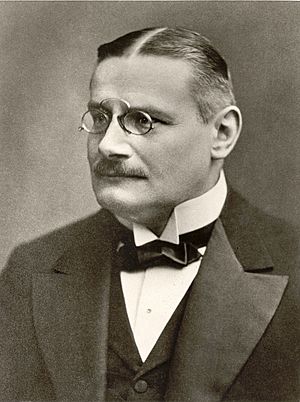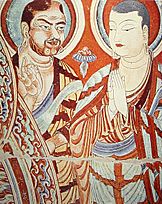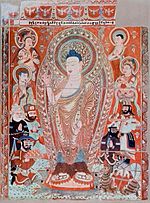Albert von Le Coq facts for kids
Albert von Le Coq (born September 8, 1860, in Berlin, Prussia, died April 21, 1930, in Berlin, Germany) was a German businessman who owned breweries and sold wine. When he was 40 years old, he decided to start studying archaeology, which is the study of human history through digging up old things.
Background
Albert von Le Coq was born in Berlin. His family came from France and were Huguenots, which were French Protestants. His family name, Le Coq, shows his French roots.
He inherited a lot of money from his family's businesses. They owned breweries and wineries across Central Europe and Eastern Europe. This wealth allowed him to travel and study whatever he wanted. One of the breweries he owned, A. Le Coq, is still in business today in Tartu, Estonia.
Career as an Archaeologist
Because he was wealthy, Albert von Le Coq became a well-known archaeologist and explorer. He focused his explorations on Central Asia.
Right image: A scene from temple 9 (Cave 20) showing people praying to the Buddha. Albert von Le Coq thought these figures were Persian people because of their features and green eyes. He also noted the donkey and Bactrian camel carrying goods. Modern experts now identify these figures as Sogdians, who lived in the Turpan area.
Von Le Coq believed that the influence of Ancient Greece could be found far away in China. However, organizing trips to Central Asia and China was very expensive. A letter found in the Prussian State Archive Königsberg shows that the last German emperor, Wilhelm II, helped pay for von Le Coq's trips. Emperor Wilhelm II was very interested in Greek culture and gave 32,000 German gold marks to support one of the expeditions.
Albert von Le Coq worked at the Museum für Völkerkunde (now called the Ethnological Museum of Berlin) in Berlin. He was an assistant to the museum's head, Professor Albert Grünwedel. Le Coq helped plan and organize trips to areas in western Asia, especially along the Silk Road, like Gaochang. The Silk Road was an ancient network of trade routes connecting the East and West. When Professor Grünwedel became sick before the second trip, Le Coq was chosen to lead it. He later wrote a book about his second and third German expeditions to Turpan, which was published in English in 1928 as Buried Treasures of Chinese Turkestan.
During these expeditions, the teams discovered many Buddhist and Manichaean cave temples in the Xinjiang region of Northwest China. Manichaeism was an ancient religion. Many old writings found in the caves were damaged during the digging. However, von Le Coq thought he had found a large Manichaean library. Some of the paintings also made him believe he had found signs of a culture related to the Franks.
With the help of his assistants, like Theodor Bartus, Le Coq carefully removed over 360 kilograms (about 305 cases) of artifacts. These included wall carvings and valuable religious items. They were then shipped to the museum in Berlin. In his book, Le Coq said that taking these items was necessary because the area was unstable at the time. However, many Chinese people see this as a "colonial rapacity," similar to how the Elgin Marbles were taken from Greece or the Koh-i-Noor diamond from India. The artifacts were displayed at the museum until 1944. Sadly, they were destroyed during a British bombing raid in World War II.
See also
 In Spanish: Albert von Le Coq para niños
In Spanish: Albert von Le Coq para niños





